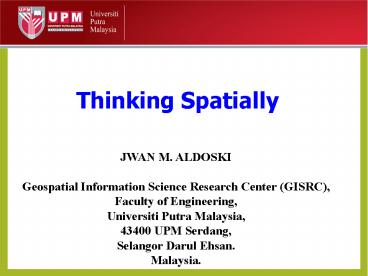Thinking spatially - PowerPoint PPT Presentation
Title:
Thinking spatially
Description:
Thinking spatially – PowerPoint PPT presentation
Number of Views:82
Title: Thinking spatially
1
Thinking Spatially
JWAN M. ALDOSKI Geospatial Information Science
Research Center (GISRC), Faculty of Engineering,
Universiti Putra Malaysia, 43400 UPM Serdang,
Selangor Darul Ehsan. Malaysia.
2
- Spatial data exploration - How to represent our
world and environment digitally, graphically and
numerically - Important considerations
- Scale
- Aspatial/spatial data
- Discrete/continuous data
- Measurement
- Location
- Spatial relationships
3
Effect of scale on Spatial dimension A house on
a close-up aerial view appears to have length
and width, but as we pull back its length and
width dimensions disappear, leaving as with house
as a point
4
Spatial Elements
- Fundamental classification of real world
phenomena and objects represented in a GIS - 4 basic types points , lines , areas (polygons),
and surfaces - Points, lines and areas can be represented by
symbols - Surfaces are represented by point elevations
- All data are explicitly spatial
- Attribute - Aspatial data
5
Spatial Elements
6
Surface features
- Continuous objects or phenomena - surface
composed of infinite number of Z values -
sampling is used to represent surface in GIS - Stored as a grid of cells in raster GIS
- Stored as a Triangulated Irregular Network (TIN)
in vector GIS (special kind of vector data) - Physical surfaces - e.g., topography
- Abstract surfaces - concentration of pullutants
in a body of water - 2.5D vs. 3D
7
(No Transcript)
8
Discrete and Continuous data
- Continuous data objects which have no definite
boundary, generally no "empty" space and assumed
to have three dimensions X,Y and Z e.g.
elevation, temperature, and rainfall. The data is
represented as surface in GIS - Discrete data objects which occupy a specific
location in space at a given point in time e.g.
road, river, and lot.and represented as point,
line, or area feature in a GIS
9
Continuous vs. Discrete
10
Measurement Levels
- Attributes - information which describes the
spatial entities, usually stored in a database
linked to the map features. Levels of measurement
used to describe data (spatial and aspatial) - Nominal scale data
- nominal name , allows us to make
differentiation between objects, does not allow
us to rank objects, does not permit quantitative
comparison e.g., land cover types (forest,
water, roads, urban, etc.)
11
Measurement Levels-continue
- Ordinal scale data
- ordinal order , allows us to rank
observations, does not permit
quantitative comparisons, e.g.,
good, fair, poor large, medium, and small - Interval scale data
- numbers are assigned to observations/entities,
permits quantitative comparison,
e.g., soil temp. measured at Farenheit scale,
does not permit ratio level comparisons e.g.,
soil at 50 deg. is not twice as warm as a soil of
25 deg., why? 0 on the scale in interval
measurement is arbitrarily defined (does not
represent the absence of quality
being measured)
12
Measurement Levels-continue
- Ratio scale data
- Numeric scale is defined by an absolute 0
(e.g., Kelvin temp. scale), e.g., monetary scale
permits quantitative comparison as
well as computation of ratios
13
Measurement Levels-continue
14
Populations and Sampling Schemes
- Sampling - looking at a subset of individuals in
a population to make some inferences about the
entire population - Target population - collection of all objects or
phenomena of which we wish to know something - Sampling area - spatial extent of area being
sampled - Sampling frame - target population sampling
area
15
Types of sampling strategies
- Random - all entities have equal probability of
being selected - Systematic - selection of entities based upon
some systematic design e.g., every 10th tree in
a transect, soil temperature collected every 100
feet - Stratified - dividing the population into spatial
subsets or thematic subsets before sampling
e.g., X number of samples are to be taken
from each of 4 plots - Homogeneous - opposite of stratified, all objects
in population are considered part of one
homogeneous group, no separation or
stratification is used
16
Making inferences from spatial data
- Sampling leaves gaps in our knowledge of
unsampled areas - Need to predict the missing points
17
Spatial data model
- Vector model
- Raster model
as geometric objects points, lines,
polygons
as image files composed of grid-cells
(pixels)
18
PLEASE Thinking Spatially
- AND THANK YOU































